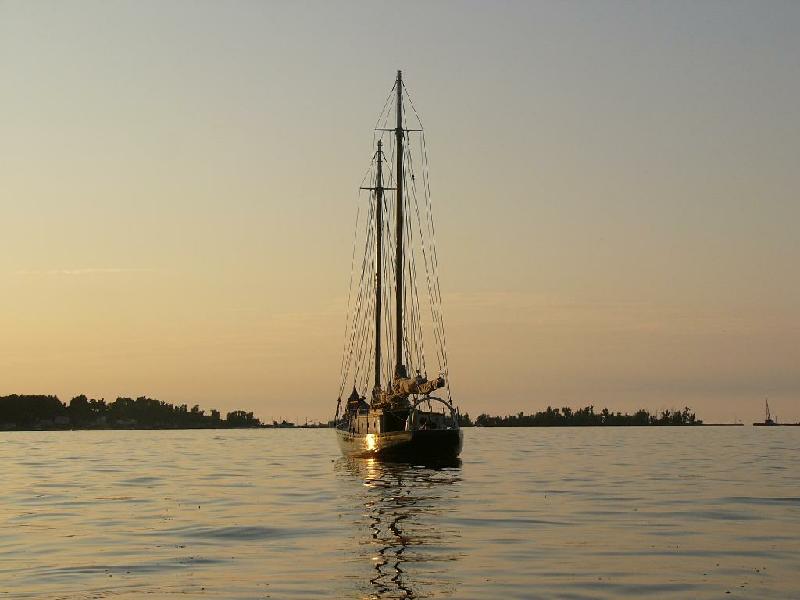Sailing
Traditions
There
are many aspects of sailing that appeal- the quiet, the beauty of nature
and one that draws me is the tradition that goes with this hobby. What is
a pastime today was once a means of making a living. Even fifty years ago a few
places in North America still saw working sail on their waters, and the rich
literature of sea faring by the likes of Conrad, Masefield, and London, men who
sailed for a living, still makes compelling reading today.
Regular
Log readers know from the link listed on the log index (recent schooner arrival) of my
involvement with sailing tradition in the form of a 38 foot Tancook schooner.
Ironically Fair Haven is home to another schooner of Tancook ancestry, that
being an accurate replica of the 28 foot double ended lapstrake Tancook whaler.
It’s owner, a historian, loaned us two books on the heritage of Tancook boats.
Knowing more about the conditions and needs that shaped the hull and rig of
Sara B has made me appreciate just how keenly the old time boat users and
builders observed the natural world and
adapted to it.
The
Tancook Islands lie on Mahone Bay a big dent on the east side of Nova Scotia.
It’s a place where able seaworthy small vessels are crucial to ones survival.
Here about 900 people fished and farmed in the early 1900s. A number of them
also built boats. As fishing stocks dwindled and the need for small sailing
freighters diminished with road construction, the island boat builders moved to
the mainland and kept building now turning out yachts or motorized fishing
craft. One who left was a Ray Stevens who around 1950, we’re told, passed on
some of his boat building knowledge to a group of apprentices during
construction of a 38 foot hull.
By then most inshore Nova Scotia fishing was done by powered vessels but the memory of the working Tancook schooner that had gained a wide reputation among the yachting set was still strong. Building from a half hull and recall of successful boats of the 1920s and 30’s boats such as Langille’s 35 footer the Cimba made famous in Murray’s book, Stevens and the apprentices laid out a traditional hull that would have been right at home carrying cabbages or mackerel in 1920.
When
a buyer for the completed hull turned up, it was rigged with traditional spliced served galvanized wire, dead eyes,
lanyards and wooden blocks. One departure from local tradition was installation
of a two cylinder diesel from England rather than one of the cranky gasoline
“make and breaks” made locally.
As
a yacht the little schooner had the usual long boxy square deck house that
seems typical of her breed, in lieu of the two deck hatches of an open work
boat. She also got a caulked seam deck and a selection of imported woods
including yellow pine and white oak and a bit of mahogany and teak trim as
befits a yacht. But the essential hull form was that of an authentic working
sailboat, not a modification to go yachting such as Alden or Hand employed in
their adaptations of working fishermen to pleasure boats as seen locally in
“Malabar X” of Seneca Day Sails or “Lotus”, the Sea Scout boat on Sodus Bay.
The
Tancook boat was adapted to carrying loads of fish or freight. They were required
to heave to and lie quietly to a drift net or while their crews hand lined. And
they needed to be easy steering easy handling boats with a reasonable turn of
speed that were also steady under foot and sea kindly. These are attributes
that some sailors who cruise still prize today.
We’re
still learning about the ”character” of the traditional inshore work boat hull
adapted to cruising for pleasure, but what we’ve seen so far we like. We hope
to learn more about both the vessel and someday about the waters she was
designed for so very far down the St. Lawrence from her present homeport. Who
knows. Perhaps someday we’ll sail those cold northern waters where her type
once hauled cabbages and sauerkraut and salted fish. Meantime, anyone out there
know how to tack a fisherman staysail?

Here’s
a link to the elementary school website on Tancook Island as it’s seen today
through the eyes of its kids. There aren’t very many of them still going to
school on island, but they’re right up to date in their one room school house,
one of the last in Canada they say. Visit them at this link here